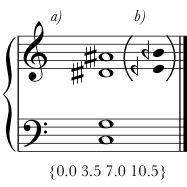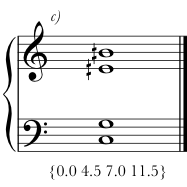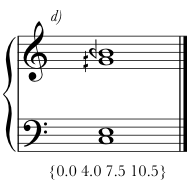Example 4.1
a) A-chord; b) A-chord respelled; c) and d) rejected candidates for primary sonorities
Example 4.1a below is a literal transcription of Ives's primary sonority; Ives notated the upper notes with sharps, which then become three-quarter-sharps when raised. I prefer the spelling in 4.1b, because I hear this chord as an altered C–E–G–B seventh chord. This chord is symmetrical and sounds stable, and as such, makes a good chord to land on at a cadence. The pairs of perfect fifths give this chord resonance.
Example 4.1c is one of Ives's rejected candidates for the primary sonority; it features resonant perfect fifths but exhibits more tension than Example 4.1a. Example 4.1d is another rejected candidate; this chord is much more dissonant than the previous two.
Throughout the chapter, I refer to this primary sonority as an "A-chord".



